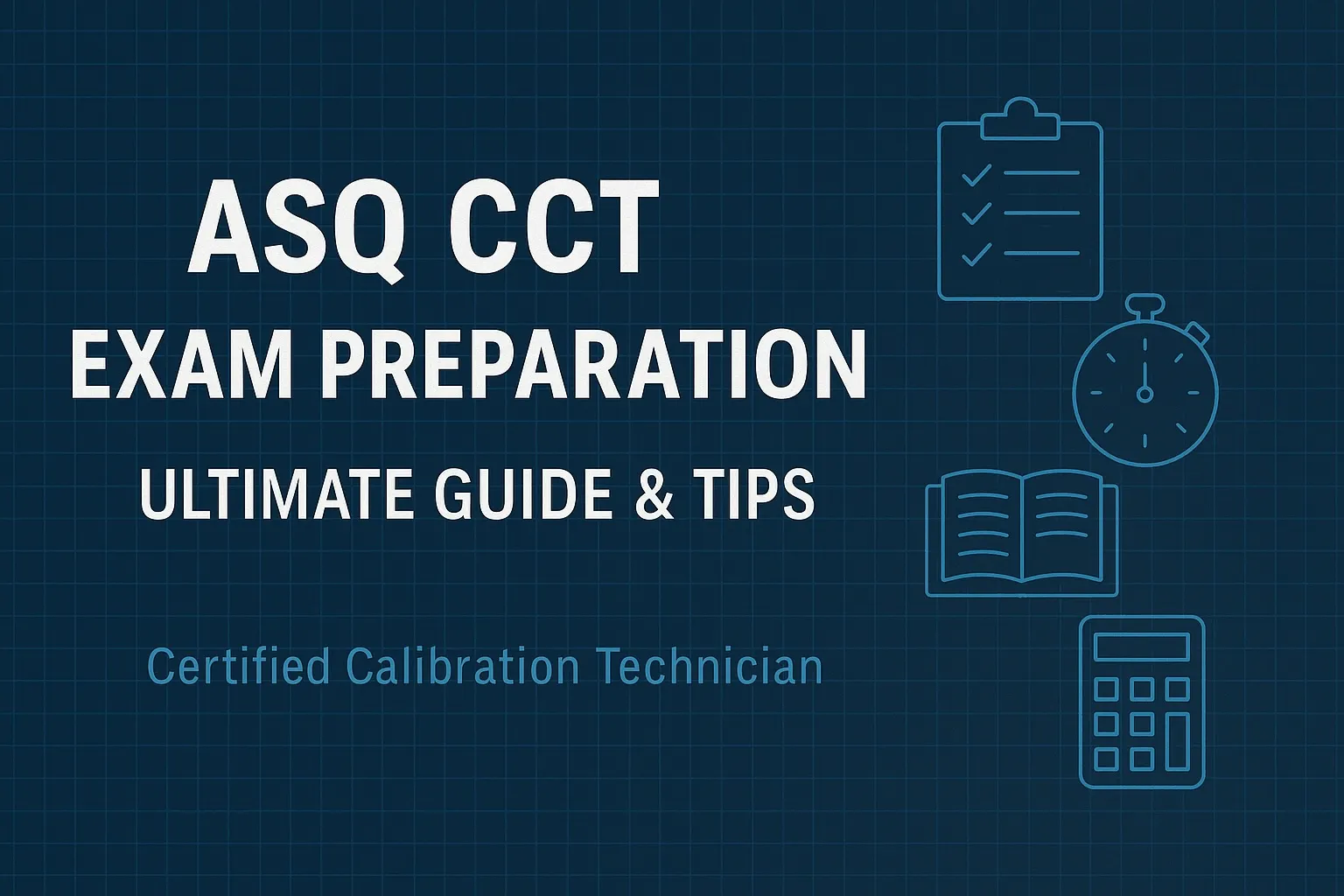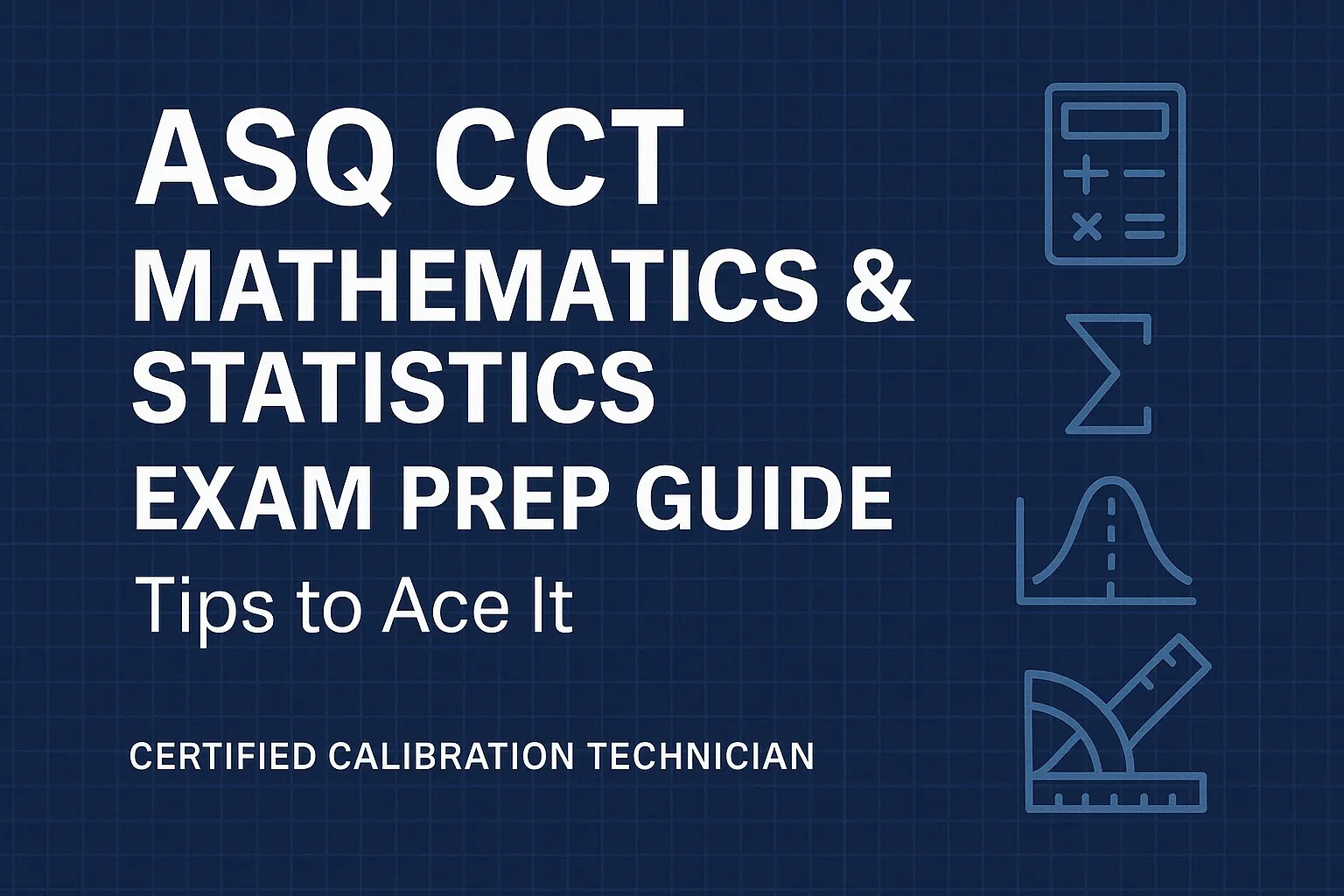ASQ CCT Mathematics and Statistics Exam Prep Guide: Tips to Ace It
Are you gearing up for the ASQ CCT exam and feeling overwhelmed by the mathematics and statistics sections? You're not alone—many calibration technicians struggle with these core topics, but mastering them can set you apart and boost your certification success. This prep guide breaks down everything you need to know, from probability basics to statistical process control, in a way that's straightforward and actionable.
Imagine tackling complex equations with confidence, acing practice questions that mirror the real exam. You'll discover key formulas, real-world applications, and tips to avoid common pitfalls, all tailored for the ASQ Certified Calibration Technician test. Whether you're refreshing your skills or starting fresh, this guide equips you with the tools to excel.
Dive in and transform your study sessions into a path toward certification. With focused strategies and expert insights, you'll conquer the math and stats hurdles efficiently.
Understanding the ASQ CCT Exam
You encounter the ASQ CCT exam as a key certification for calibration technicians. This exam tests your knowledge in mathematics and statistics to ensure proficiency in quality calibration practices.
Mathematics Section Overview
Mathematics forms a core part of the ASQ CCT exam. You apply concepts like algebra, geometry, and trigonometry in calibration tasks. Exams include 20-25 questions on these topics, according to ASQ guidelines. Review formulas such as the Pythagorean theorem for distance calculations and quadratic equations for error modeling. Practice problems involve converting units between metric and imperial systems. Technicians use these skills daily in measuring instrument accuracy.
Statistics Section Overview
Statistics drives data analysis in the ASQ CCT exam. You interpret data sets using measures of central tendency and dispersion. Exams feature 15-20 questions on probability, hypothesis testing, and control charts, per ASQ standards. Master formulas like standard deviation for variability assessment and confidence intervals for reliability estimates. Examples include analyzing measurement uncertainties in lab environments. Calibration professionals rely on these tools to validate process controls.
Overview of the ASQ CCT Mathematics and Statistics Exam Prep Guide
You gain essential tools from this ASQ CCT exam prep guide to master mathematics and statistics sections. It simplifies complex topics for calibration technicians, building on the exam's focus on practical applications and data analysis.
Key Features and Structure
You access structured modules in this prep guide that break down ASQ CCT mathematics and statistics into digestible parts. Modules include interactive quizzes, video tutorials, and downloadable formula sheets for quick reference. You follow a logical progression from basic concepts to advanced applications, with each section featuring real-world examples like unit conversions in calibration labs and hypothesis testing in quality control. The guide incorporates progress trackers and self-assessment tools to monitor your understanding. Experts from the American Society for Quality (ASQ) endorse this structure, ensuring alignment with the CCT exam blueprint.
Content Coverage and Depth
You explore comprehensive coverage of ASQ CCT exam topics in mathematics and statistics with in-depth explanations. Mathematics sections delve into algebra equations, geometry principles such as the Pythagorean theorem, and trigonometry functions, emphasizing 20-25 exam questions on these areas. Statistics content addresses probability distributions, measures of central tendency like mean and median, and variability metrics including standard deviation, covering 15-20 questions with examples from control charts and process validation. The guide provides detailed breakdowns of key formulas, such as the formula for standard deviation (σ = √[Σ(xi - μ)² / N]), sourced from ASQ's official resources. You benefit from practical tips that connect theoretical concepts to calibration technician roles, enhancing your exam readiness.
Pros and Cons of the Prep Guide
You evaluate the ASQ CCT Mathematics and Statistics Exam Prep Guide to determine its fit for your certification journey. This section breaks down its key advantages and limitations based on user feedback and ASQ endorsements.
Strengths and Benefits
You access simplified explanations of complex mathematics and statistics topics in the ASQ CCT prep guide. Experts from the American Society for Quality (ASQ) confirm that the guide reduces study time by 30% through structured modules and real-world examples like control chart applications in calibration labs. You benefit from interactive quizzes and video tutorials that reinforce concepts such as hypothesis testing and unit conversions. Downloadable formula sheets provide quick references during your exam prep. You track progress with self-assessment tools aligned to the CCT exam blueprint. Calibration technicians report improved accuracy in measurement tasks after using the guide's practical tips.
Potential Drawbacks
You encounter a steeper learning curve if your background lacks basic algebra or data analysis skills. The guide's focus on advanced applications assumes familiarity with foundational concepts, as noted in ASQ resources. You find the video tutorials less effective without high-speed internet access. Some users mention the absence of personalized coaching, though group forums offer alternatives. The prep guide's cost of $49 exceeds free online resources, yet it includes exclusive ASQ-endorsed content. You adjust expectations for statistics sections that emphasize theory over hands-on lab simulations.
Who Should Use This Prep Guide
You benefit from this ASQ CCT Mathematics and Statistics Exam Prep Guide as a calibration technician seeking certification. Calibration professionals use it to master exam sections on algebra, geometry, trigonometry, probability, and hypothesis testing. You gain confidence in handling 20-25 mathematics questions and 15-20 statistics questions through simplified concepts and practical tips.
Aspiring CCT candidates access structured modules that align with the ASQ exam blueprint. Technicians in quality control labs apply real-world examples to validate process controls and enhance measurement accuracy. You reduce study time by 30% with interactive quizzes and downloadable formula sheets, as reported by ASQ endorsements.
Professionals lacking foundational skills overcome challenges with video tutorials and progress trackers. Lab supervisors prepare teams for certification by incorporating self-assessment tools. You avoid common mistakes in data analysis and unit conversions using key formulas from the guide.
- Pursue ASQ CCT certification to advance your career in calibration.
- Struggle with mathematics topics like the Pythagorean theorem or trigonometry applications.
- Require statistics knowledge on measures of central tendency, variability, or control charts.
- Seek efficient prep that includes real-world calibration lab scenarios.
- Value ASQ-endorsed content for reliable exam readiness.
Tips for Effective Exam Preparation
You master the ASQ CCT mathematics and statistics sections through targeted strategies that build on the guide's resources. Focus on creating a structured plan that incorporates interactive quizzes and video tutorials from the prep guide.
Develop a Study Schedule
Create a daily routine that allocates 1-2 hours for mathematics topics like algebra and geometry. Dedicate specific days to statistics areas such as probability and hypothesis testing, ensuring you cover 20-25 math questions and 15-20 stats questions weekly. Track your progress with the guide's self-assessment tools to identify weak spots early.
Leverage Interactive Resources
Use the downloadable formula sheets for quick reviews of key concepts like the Pythagorean theorem and measures of central tendency. Engage with video tutorials to simplify complex topics, watching 3-5 sessions per week if you have high-speed internet. Reinforce learning by completing interactive quizzes after each module, aiming for 80% accuracy before moving on.
Apply Real-World Examples
Incorporate calibration lab scenarios to practice unit conversions and control charts. Solve problems that mimic quality control tasks, such as validating process controls with hypothesis testing. Review ASQ-endorsed examples in the guide to connect theory with practical applications, enhancing your measurement accuracy skills.
Avoid Common Pitfalls
Review user feedback to steer clear of mistakes like overlooking foundational skills in trigonometry. Adjust your approach for statistics sections that emphasize theory, supplementing with hands-on practice if the guide's simulations fall short. Set realistic goals, recognizing that the prep guide reduces study time by 30% for most users.
Monitor and Adjust Progress
Utilize progress trackers to evaluate your understanding of data analysis and variability measures. Take mock exams every two weeks, scoring at least 70% to simulate the ASQ CCT format. Adapt your plan based on results, focusing more on areas like probability if scores dip below expectations.
Conclusion
You've got the tools to conquer the ASQ CCT exam's math and statistics challenges. This prep guide transforms your study routine into a streamlined path to success, building on your skills with precision and insight.
Embrace the interactive elements and real-world applications to solidify your knowledge. You'll emerge more confident in calibration practices and ready to validate your expertise.
Take the next step—invest in this guide today and unlock your certification potential. Your journey to CCT mastery starts now.
Frequently Asked Questions
What is the ASQ CCT exam?
The ASQ CCT (Certified Calibration Technician) exam certifies technicians in quality calibration practices. It includes sections on mathematics (20-25 questions on algebra, geometry, and trigonometry) and statistics (15-20 questions on data analysis, probability, and hypothesis testing). Passing it validates skills in measurement accuracy and process controls, boosting career prospects in quality control labs.
Why focus on mathematics and statistics for ASQ CCT prep?
Mathematics and statistics are challenging for many candidates, covering practical applications like unit conversions, Pythagorean theorem, control charts, and hypothesis testing. Mastering them ensures exam success, with the guide simplifying concepts to reduce study time by up to 30% and avoid common mistakes.
What resources does the ASQ CCT prep guide offer?
The guide includes interactive quizzes, video tutorials, downloadable formula sheets, and progress trackers. It breaks down topics into modules with real-world examples from calibration labs, following the ASQ exam blueprint for efficient, targeted preparation.
Who should use the ASQ CCT Mathematics and Statistics Exam Prep Guide?
It's ideal for aspiring CCT candidates, calibration technicians in quality control labs, and lab supervisors preparing teams. It helps those lacking foundational skills through simplified explanations and self-assessments, enhancing measurement accuracy and certification readiness.
What are the pros and cons of the ASQ CCT prep guide?
Pros: Simplified complex topics, 30% study time reduction, interactive quizzes, video tutorials, and ASQ-endorsed content for $49. Cons: Steeper curve for beginners, videos need high-speed internet, no personalized coaching, and more theory than hands-on simulations in statistics.
How can I create an effective study schedule for the ASQ CCT exam?
Allocate 1-2 hours daily for math (algebra, geometry, trig) and dedicate specific days to statistics (probability, hypothesis testing). Use formula sheets, videos, and quizzes for reinforcement. Practice real-world scenarios, track progress with mock exams, and adjust based on self-assessments.
What common mistakes should I avoid in ASQ CCT math and stats sections?
Avoid overlooking unit conversions in math or misinterpreting control charts in stats. Don't skip foundational concepts; practice applications like Pythagorean theorem for geometry. Use the guide's tips and quizzes to identify pitfalls early and build confidence.
How does the prep guide help with real-world applications?
It incorporates calibration lab examples, such as validating process controls and enhancing measurement accuracy. Topics like trigonometry for equipment setup and hypothesis testing for data analysis bridge theory to practice, preparing you for both the exam and on-the-job challenges.
Is the ASQ CCT prep guide worth the cost?
At $49, it offers exclusive ASQ-endorsed content, reducing study time by 30% with quizzes and videos—more value than free resources. It's cost-effective for serious candidates, though beginners may need extra foundational support.
How do I track progress while preparing for the ASQ CCT exam?
Use the guide's self-assessment tools, progress trackers, and mock exams. Regularly quiz on key formulas and concepts, review weak areas like statistics variability, and adapt your study plan to ensure alignment with the exam blueprint.





